Luciano Spalletti’s side started last season off in excellent form, going unbeaten in the first 12 games. They were a free-flowing side scoring 24 goals whilst only conceding 4 times. Everything started to fall apart after injuries hit and form began to go downhill. However, this is a new and fresh start to the campaign.
Napoli have let go of some key players, though they have done some excellent business to replace those players with younger players with a higher ceiling than those before. Exciting signings such as Khvicha Kvaratskhelia, Min-jae Kim, Mathias Olivera, Giacomo Raspadori, Leo Ostigard, Giovanni Simeone, Tanguy Ndombele and Salvatore Sirigu have all come in to rejuvenate the squad, and improve their depth upon their return to UEFA Champions League football.
This tactical analysis will come in a form of a scout report to explain the tactics behind Napoli’s strong start to the season both in attack and defence. This analysis will show how Napoli have been superior in every facet of play, the reasons behind it and what we can expect from Napoli by the end of the season.
Lineups and playing style
Napoli have maintained their 4-3-3 from last season, with a focus on keeping specific profiles in key roles. Gli Azzurri have demonstrated their philosophy in the first two matches of the season, and it may be something that we see more commonly in the future. They have scored 9 goals in 2 games and have been a dominant force in the league.
In their first two games, Napoli had 54% and 66% possession and, while they dominated the ball, the first half was even more dominant in both games. Napoli had 63% and 80% possession in the first half in each, but with the Blues holding heavy leads at half-time, Napoli had a relaxed mentality and sat back as their opponents chased the game. The image below shows Napoli’s formation and starting lineups, which remained the same for both matches.
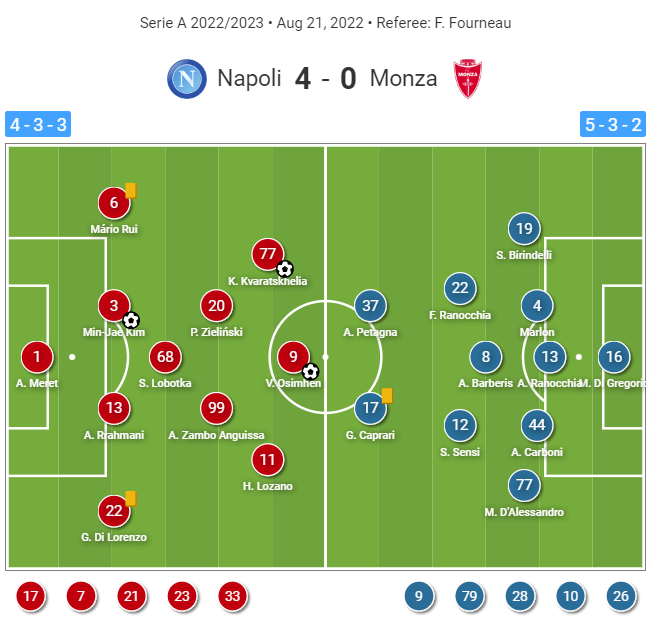
In the Serie A, Napoli haven’t been extremely tested so far, with both teams preferring to sit back and block space rather than trying to force their opponents into a mistake. As a result, Napoli haven’t spent much time on the build up, but rather on how to progress the ball from the middle to the final third. This pass map below shows the common passing patterns from Napoli’s game against Monza.
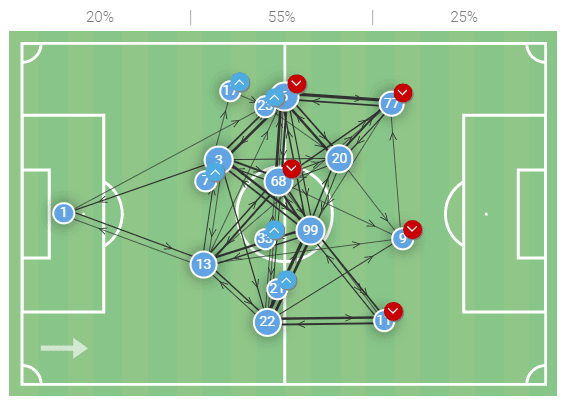
Build-up methods
Although it hasn’t been too common, there have been a few occasions when Napoli have had to progress the ball through the opposition’s press from deep areas. Napoli have been setting up in a 4-2 style when building up, with a focus on freeing up a full-back on either side for him to carry the ball into the opponent’s half. The image below shows Napoli’s shape, with a 4v7 situation.
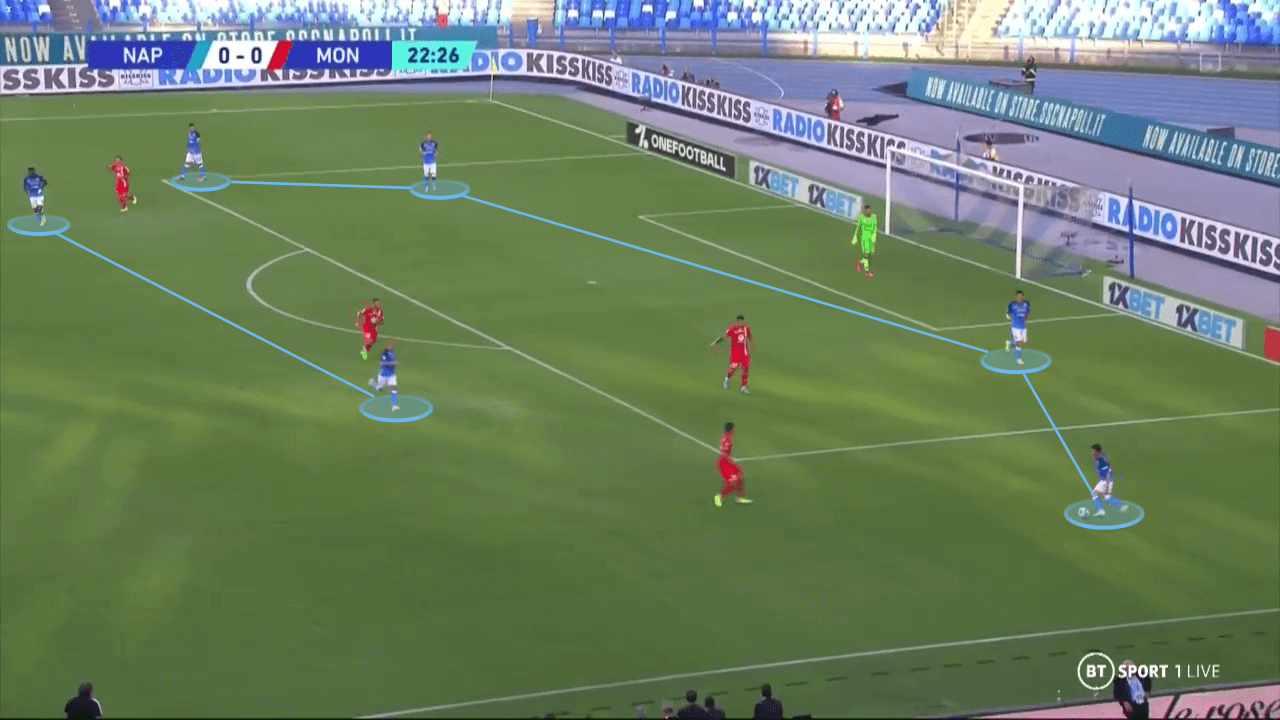
In the build up, Monza’s pressing isn’t aggressive enough, with the Napoli players having enough time on the ball to turn and find an out ball. The pattern below shows Zambo-Anguissa receiving the ball, and he has scanned prior to noticing the full back in space. Giovanni Di Lorenzo receives the ball and due to the lacklustre press, he can drive with the ball for around 50 yards forming a 4v5 attack. This led to a shooting opportunity for Piotr Zielinski, after about six passes starting from the goalkeeper.
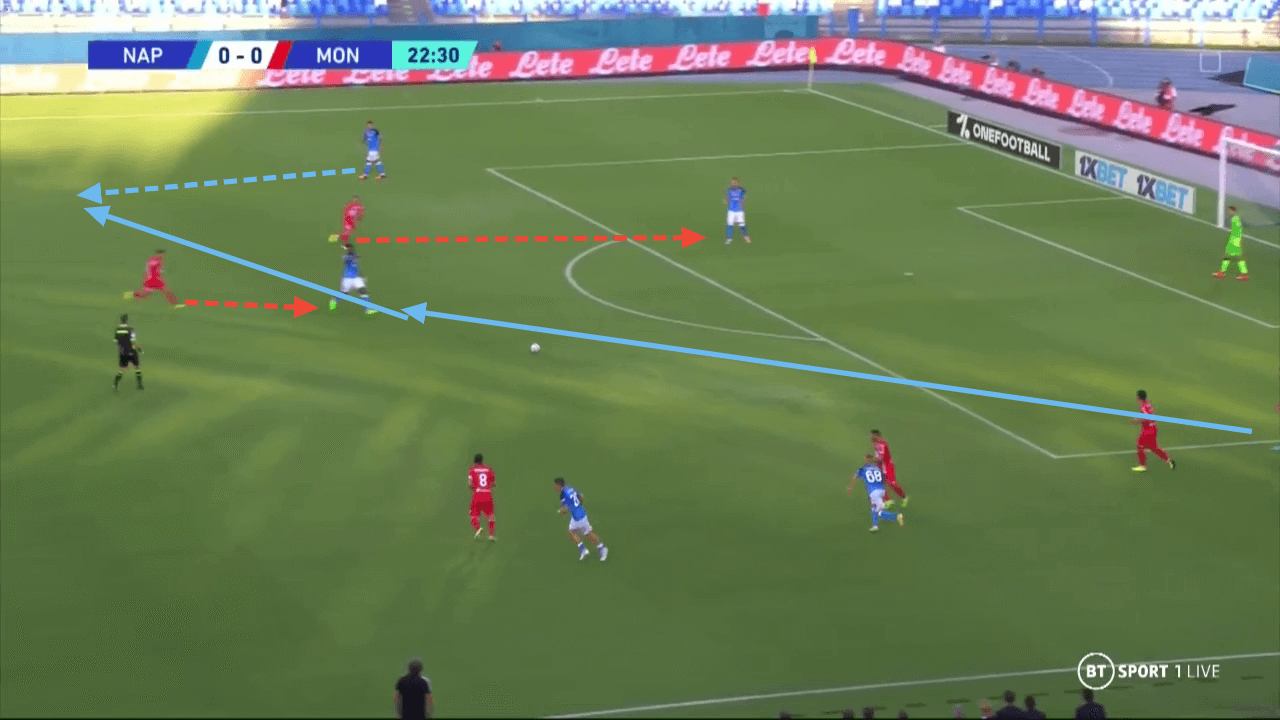
When Napoli do get pressed intensely, they have an excellent point of reference in Victor Osimhen who is wonderful technically and is physically strong enough to be able to hold the ball up from defenders and can lay off passes for oncoming teammates. As a result, Napoli are a team that are extremely difficult to press, as they have the options of passing through the press with strong technical players in the build up, whilst also possessing a physical player further up the pitch who can allow the entire team to push up the pitch with him.
This image below shows the goalkeeper going long when he is under pressure, with a lofted ball for Osimhen who heads it down for a teammate.
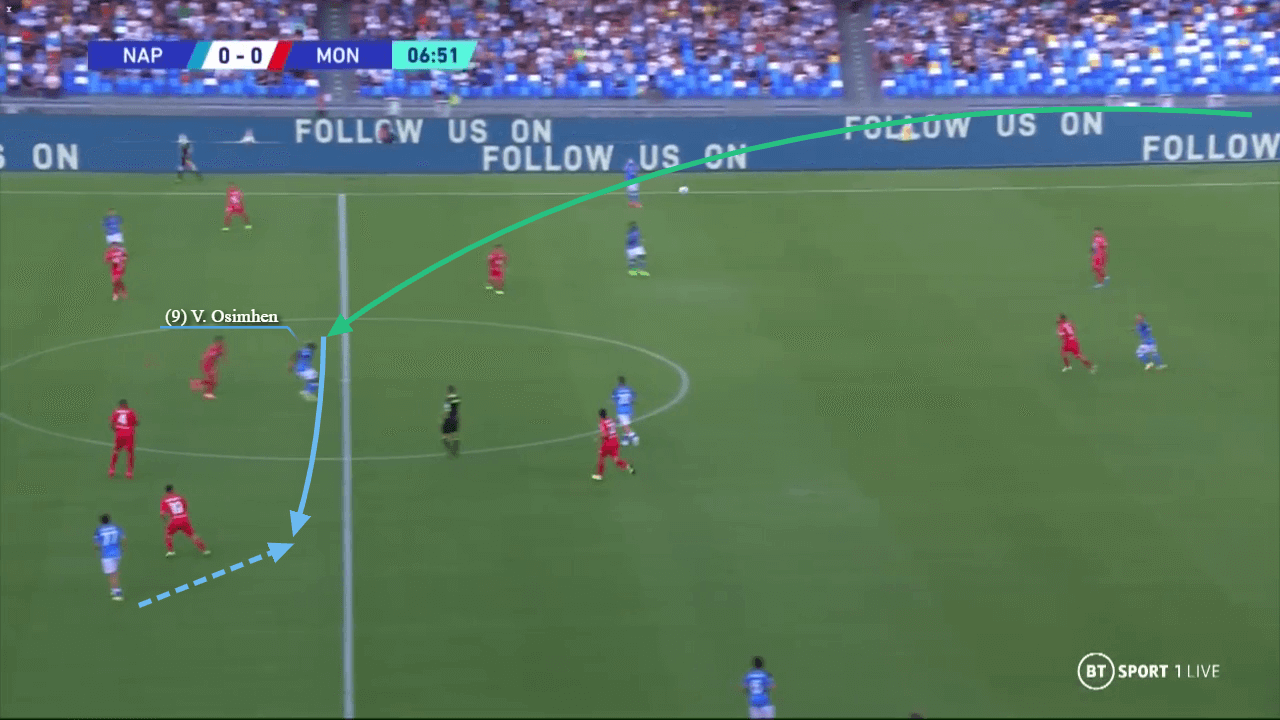
Ball progression
Luciano Spalletti has developed many interesting different methods of progressing the ball through opposition mid-blocks, which has been a common theme during the past two games. In both matches, Napoli have faced up against a 5-3-2 defence.
In a 5-3-2, the space for attacking teams is down either side, with the three midfielders having too much ground to cover without much time to do so. The Monza wingbacks are pinned back by the two Napoli wingers, while the centre backs aren’t brave enough to jump out of position to intercept the ball. This allows the four defenders and three midfielders for Napoli to have a 7v5 in the middle third. With the overload, Napoli don’t require as many players in the backline for ball retention, which allows the spare full-backs to find space further up the pitch to allow the team to progress the ball.
The image below perfectly displays the space left down both sides of the Monza midfield line, where both full-backs have stepped up to offer a progressive passing option. With minimal pressure on the ball, the Napoli centre-backs have time on the ball to manipulate an angle so that the pass to Di Lorenzo is available, who can then turn on the ball and drive at the back five, with one pass having taken five players out the game.
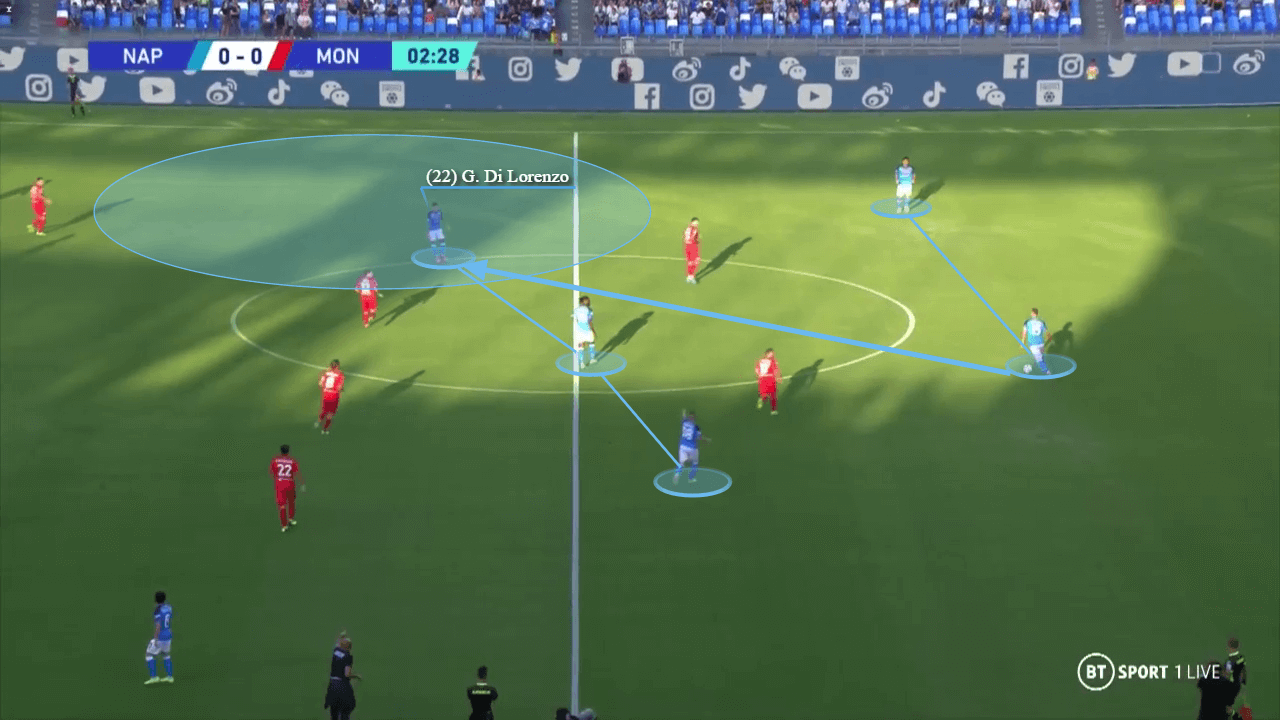
While the full back usually remain open for a progressive pass, there are times when the opposition’s midfielders do attempt to jump out of position to win the ball back. In those scenarios, the Napoli midfielders are both technically good enough and aware enough to penetrate the gaps left in the midfield line.
In this example below, the RCM from Monza steps up to block the pass to the left-back. In doing so, the other two midfielders have to move position in an attempt to cover the extra space but it is extremely difficult for two players to cover so much ground. As a result, there are big gaps which Zambo-Anguissa recognises and turns into to pass the ball to Lobotka. Stanislav Lobotka is an excellent midfielder who has gone under the radar with his great passing and smooth dribbling abilities. In this scenario Lobotka is aware enough to turn with the ball and drive through the gap between the two players, before setting the ball up for a more dangerous player in the final third.
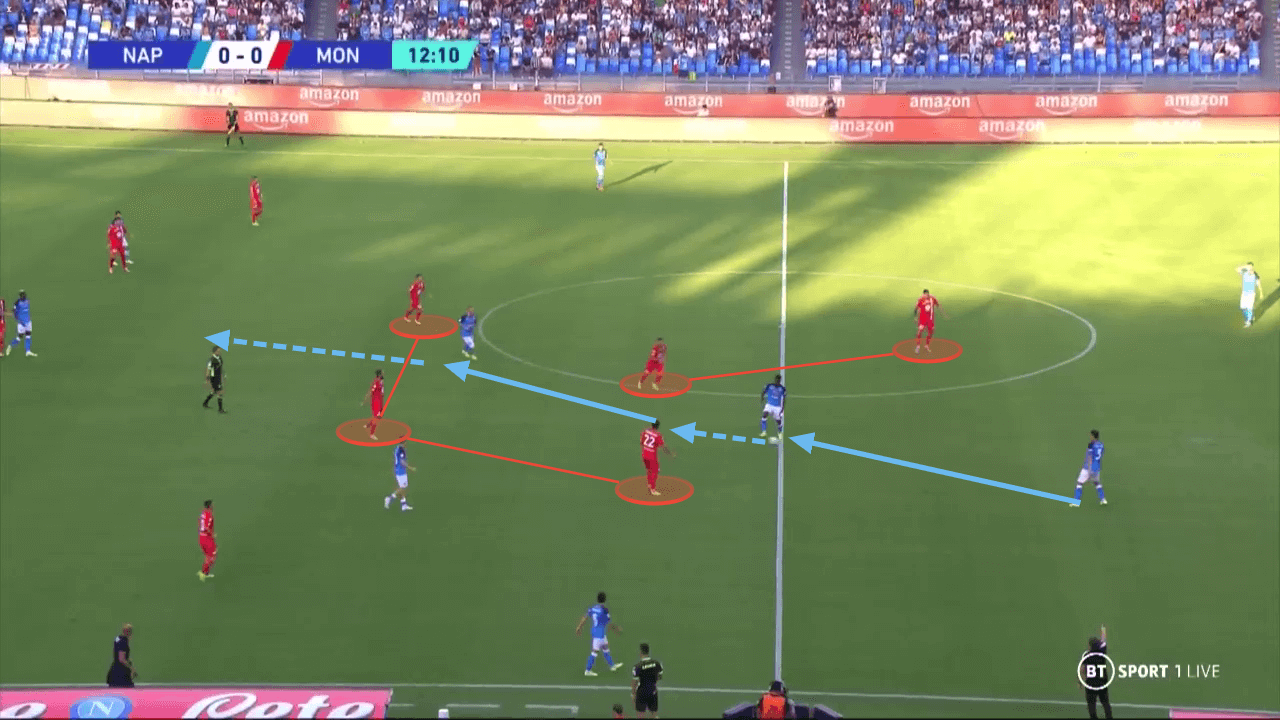
One other way in which Napoli excel at progressing the ball is through the use of wingers dropping deep to create a numerical overload. In this example below, you can see that Napoli have been pressed and so it is more difficult to retain possession of the ball. In this scenario, Hirving Lozano drops deep to create a 4v3 in the middle third. This allows Napoli to use Lozano for a bounce pass with Zambo Anguissa receiving the ball using a third man run to be in a position further up the pitch, and unmarked.
This smart use of overloads allows Napoli to be calm on the ball even under pressure or in positions further up the pitch. As a result of this move, Zambo Anguissa receives the ball on the halfway line, with a 3v3 in the final third, from where he lays the ball off to Osimhen who drove a shot into the bottom corner and scored a goal.
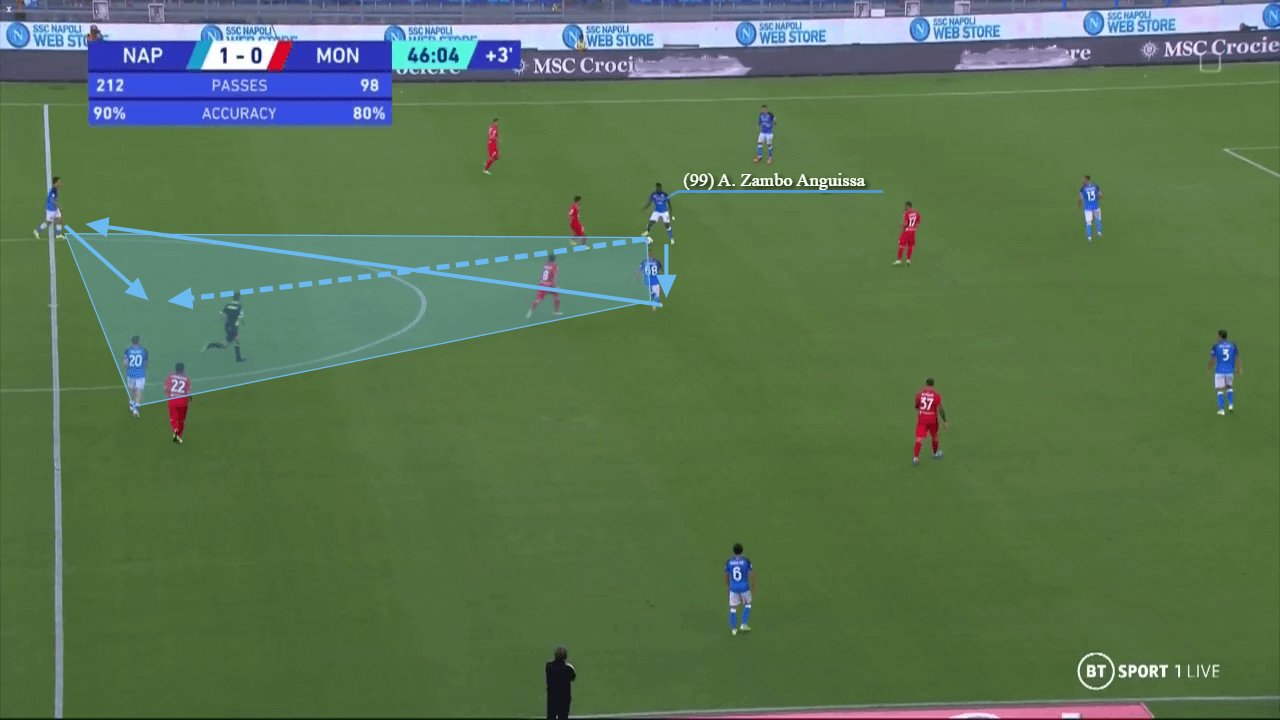
Chance creation
Whilst Napoli have been excellent in transitional situations, they have also proved their worth in being able to break down low blocks in the last two league games. A common theme has been the use of underlapping runs from the blindside of the opposition midfielders into the box. When the ball is in a wide area like pictured below, the opposition backline has to be narrow to prepare for deliveries into the box.
Simultaneously, Napoli keep a player high and wide which leaves a massive open space in the half space lane, but inside the box. From there, a player who is already in the box and can’t be seen by the opposing midfielders, roams into the open space to receive the ball in a dangerous crossing position, from which he can pick out his teammates with a cross.
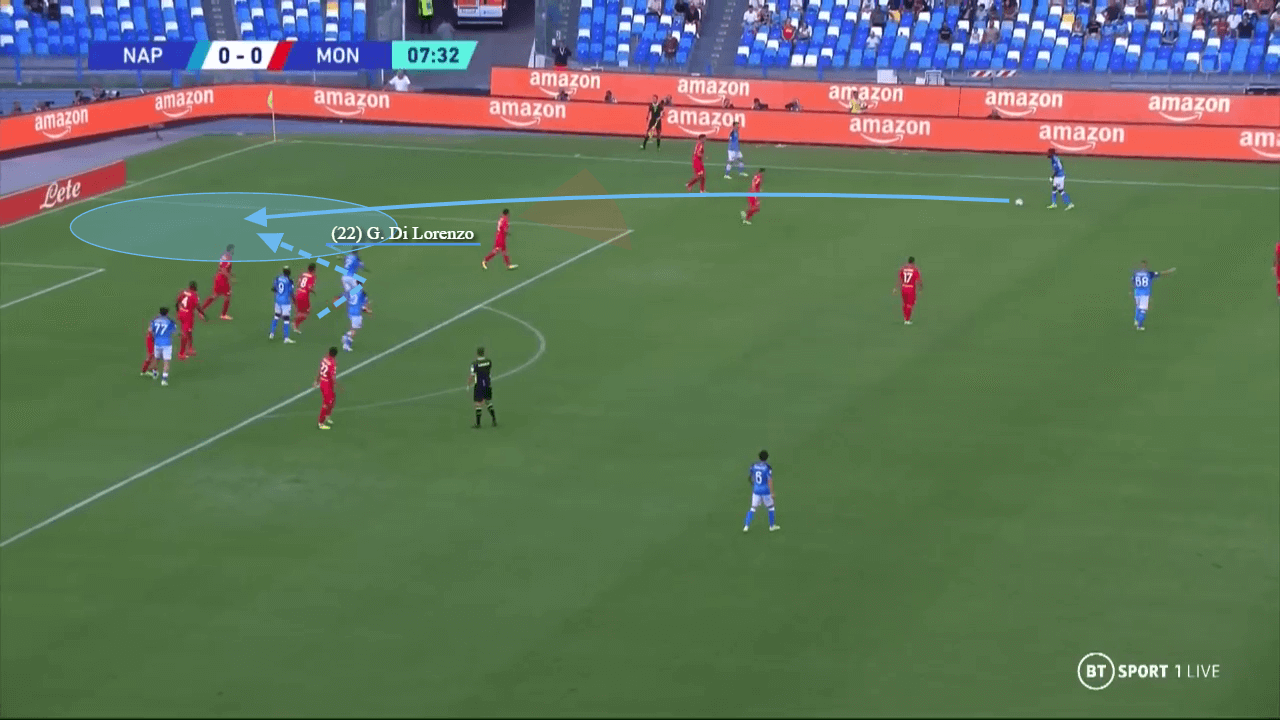
Below is another example of the same pattern, with Zielinski pretending to attack the box before curving his run to move to a wide area. In this instance, there is no wide Napoli player creating space for a pass into the box, which causes the pass to Zielinski to be wider and so it is a less dangerous situation.
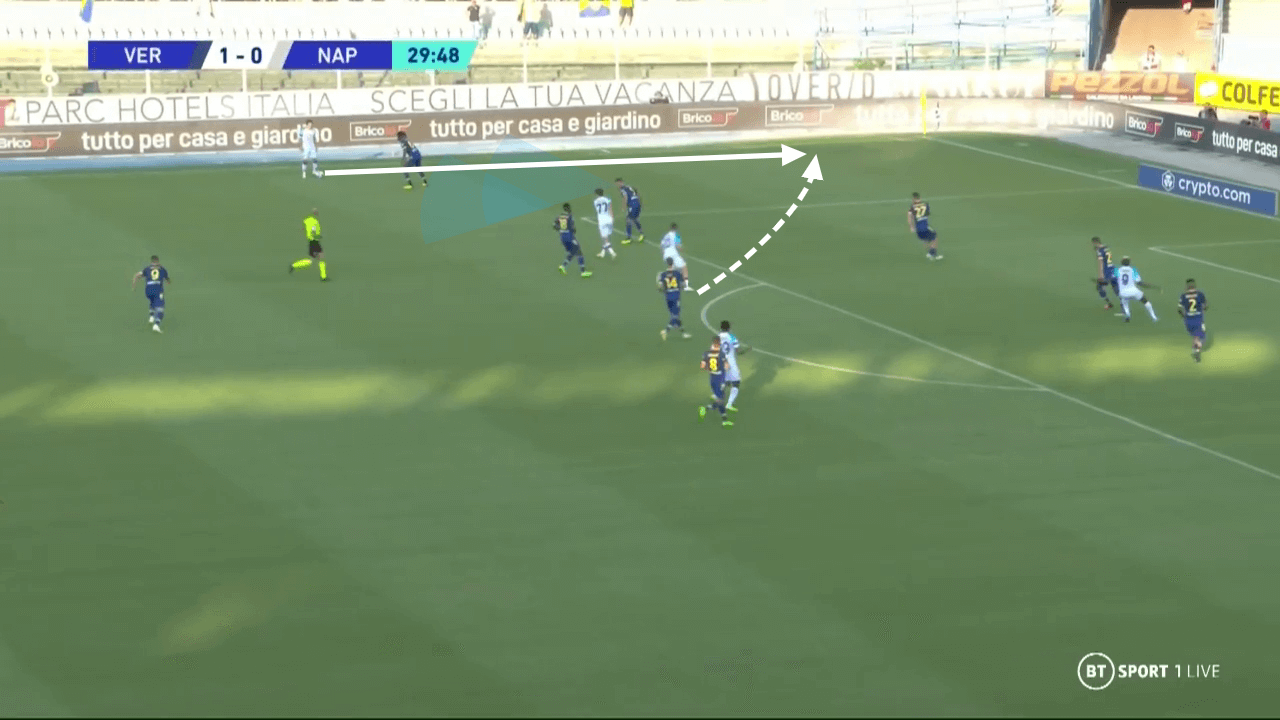
While the wide player may have caused Zielinski to move out wide, he then occupies the half space, from which Zielinski can pass to him from. Khvicha can then receive the ball inside the box, and cause chaos through his mazy runs at opposing defenders.
This system from Spalletti works really well, with the attacking players having multiple options, so that even when something may not go according to plan, they can still have players in the right positions to stretch the defence and cause problems.
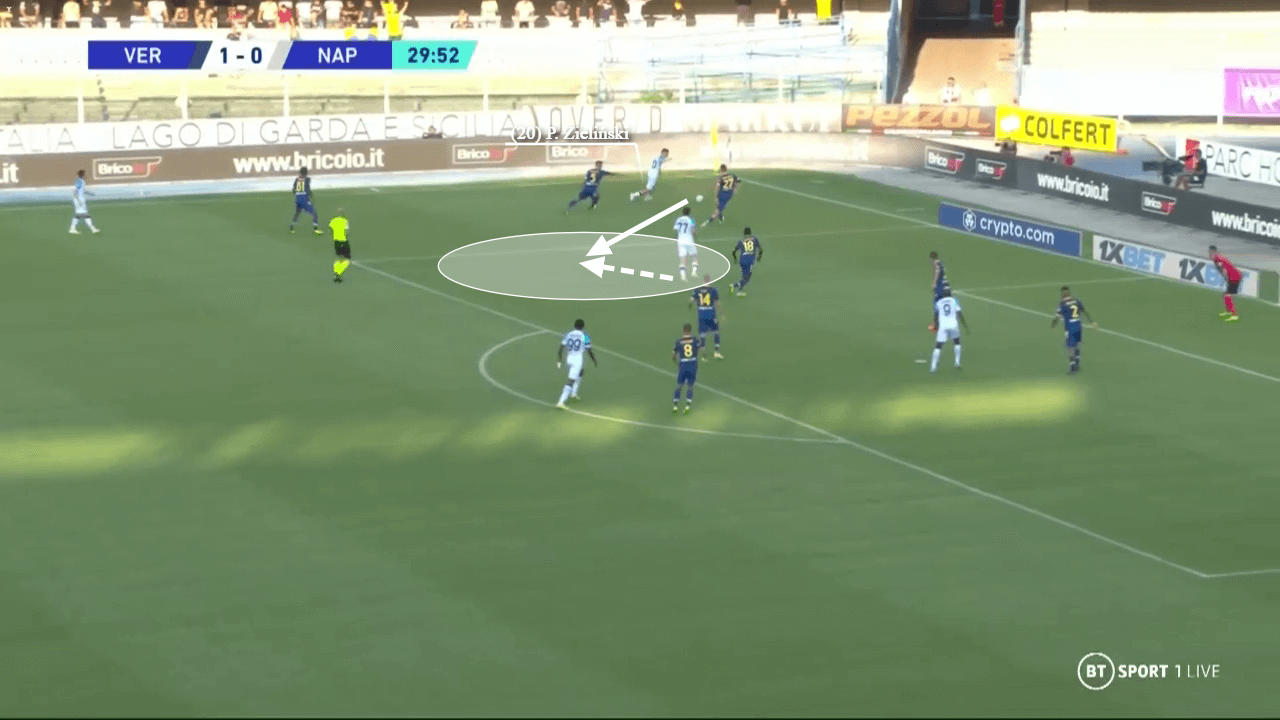
Khvicha Kvaratskhelia’s influence
One of the biggest part’s of Spalletti’s system is Khvicha, who replaced Lorenzo Insigne and has been a joy to watch since coming into the squad. He joined for a fee of £9 million and has been a revelation ever since stepping on to the pitch.
One key strength that Khvicha has displayed is his ability to remain composed and play piercing passes through compact defences. This image below highlights his ability to slot the ball through two defenders and find the striker who lays it off for Zambo Anguissa to make an effort on goal.
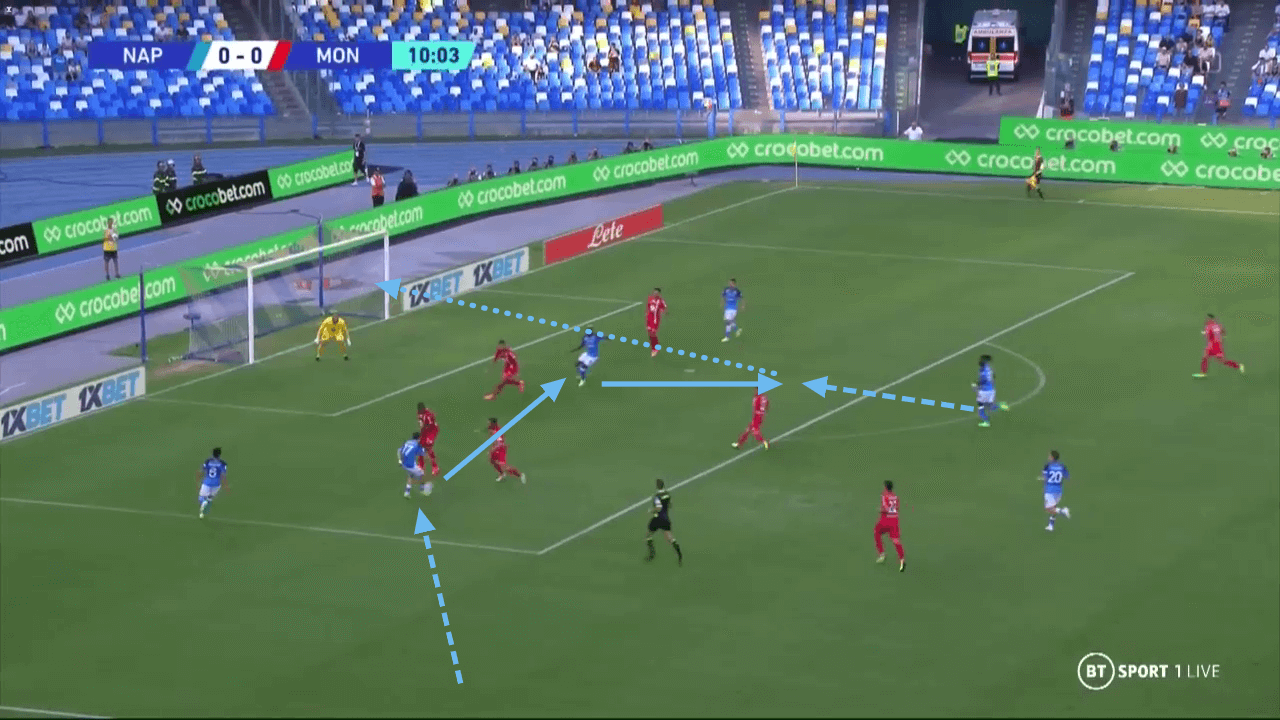
Since coming to Serie A, Khvicha has scored 3 goals in 2 games. He has scored one goal with each foot and one with his head, showing his ability to be a deadly force on either side, which makes him more unpredictable to defend against, and helps be more clinical in the box. His best goal came in the game against Monza, where Khvicha shows his amazing ball-striking abilities to place the ball into the top corner from 25 yards out.
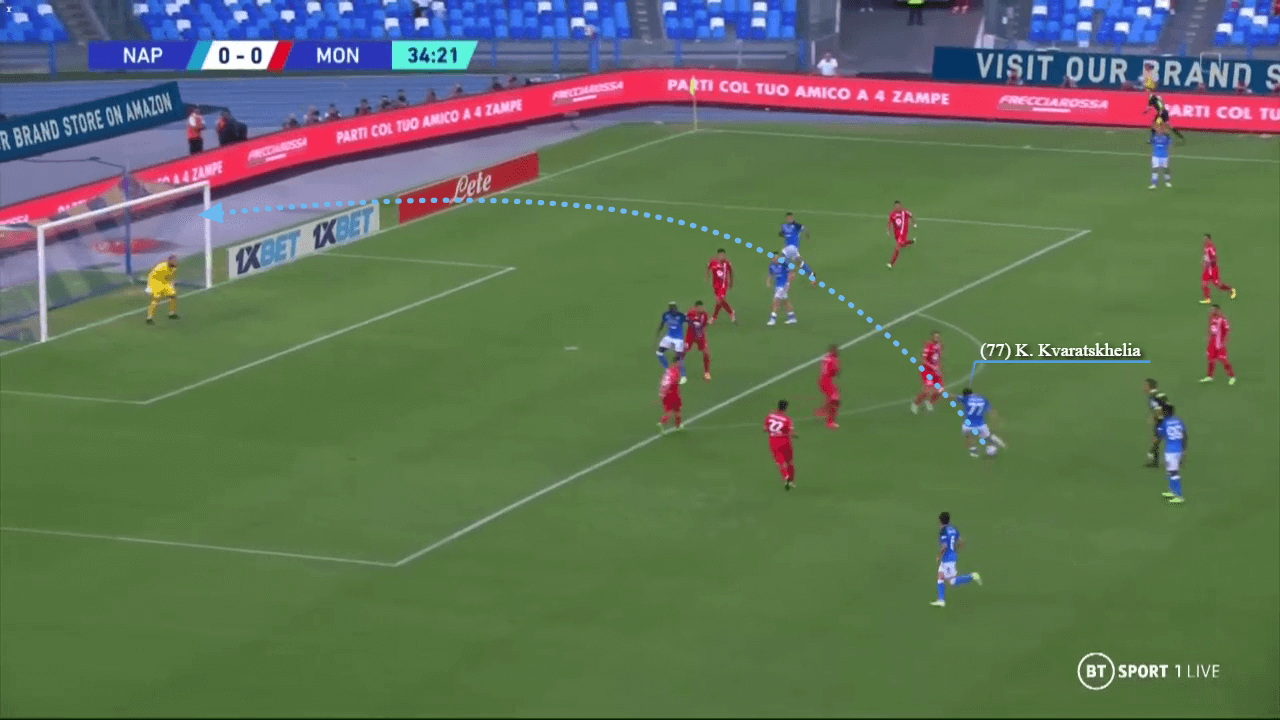
Arguably being his biggest asset, Khvicha has great dribbling abilities due to his close control, ball manipulation skills and ability to strike through the ball on either foot. In this example below, Khvicha lures a defender in to making a tackle, before shifting the ball onto his left foot after the defender is unbalanced. Khvicha then scores the goal after placing the shot into the bottom right corner with his left foot.
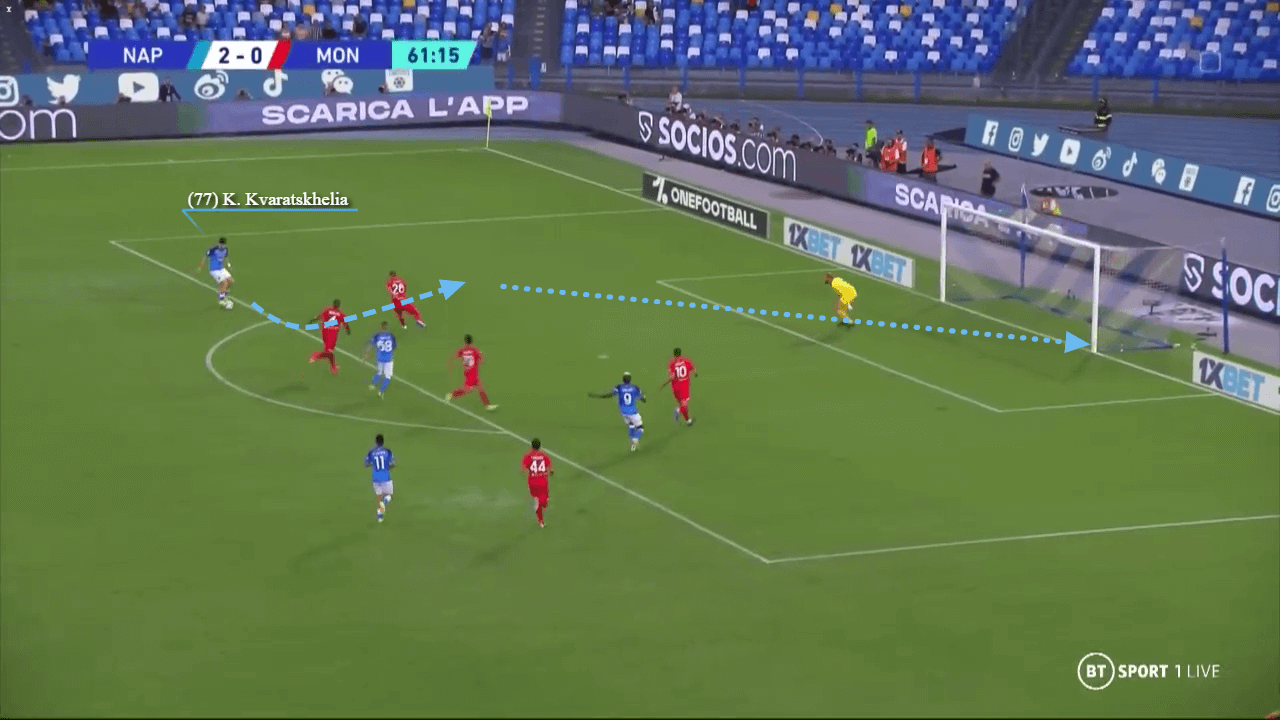
Khvicha has also displayed good awareness and scanning skills by looking around before receiving the ball. This allows him to spot Zielinski’s run which he finds with a perfectly weighted first-time pass. Khvicha has shown he is not selfish, although there are some aspects of his game such as crossing which we haven’t seen too often just yet.
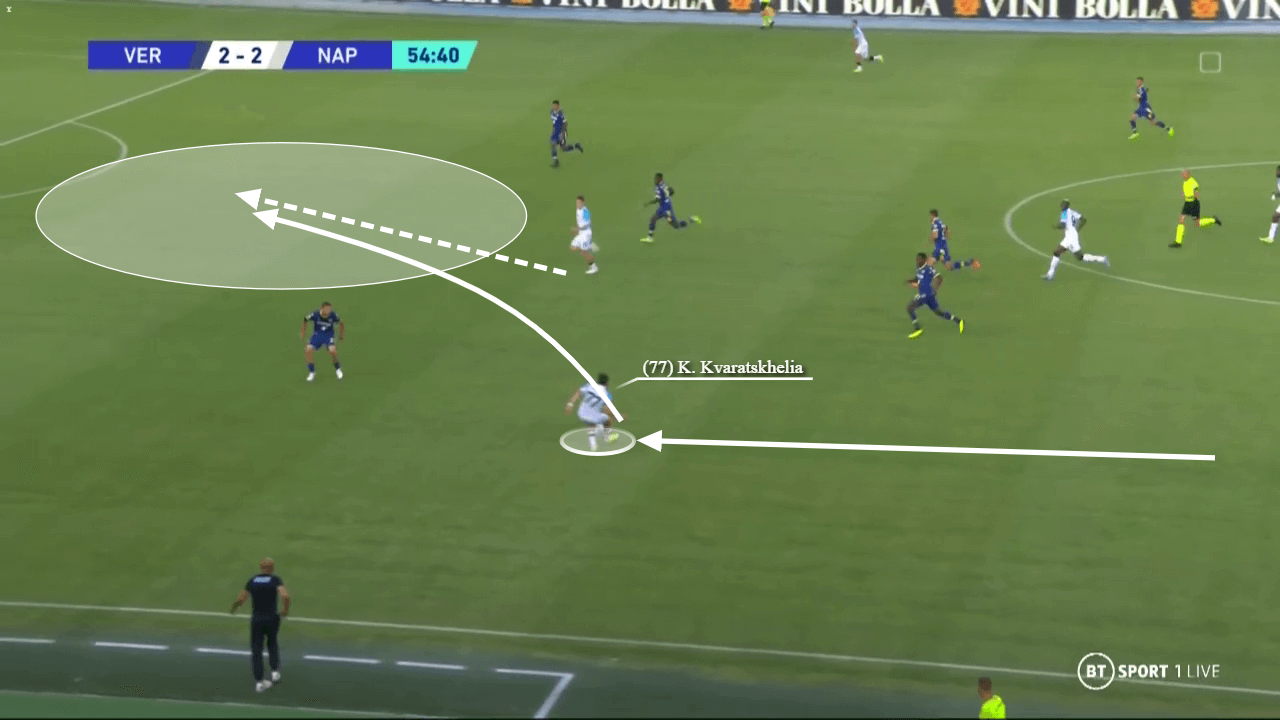
One area in which Khvicha may struggle is his lack of power in order to beat a player with space in behind. While Khvicha has shown he is capable of beating an opponent through excellent ball manipulation skills, there have been times, like in the image below, where Khvicha had plenty of space to dribble into, but waited and instead tried to lure the defender into a tackle. If this becomes a regular occurrence, opposition defenders will begin to realise they can try to delay for as long as possible, until another player comes to make it a 2v1. Khvicha will either have to become braver, or increase the power in his legs to become an unstoppable dribbler.
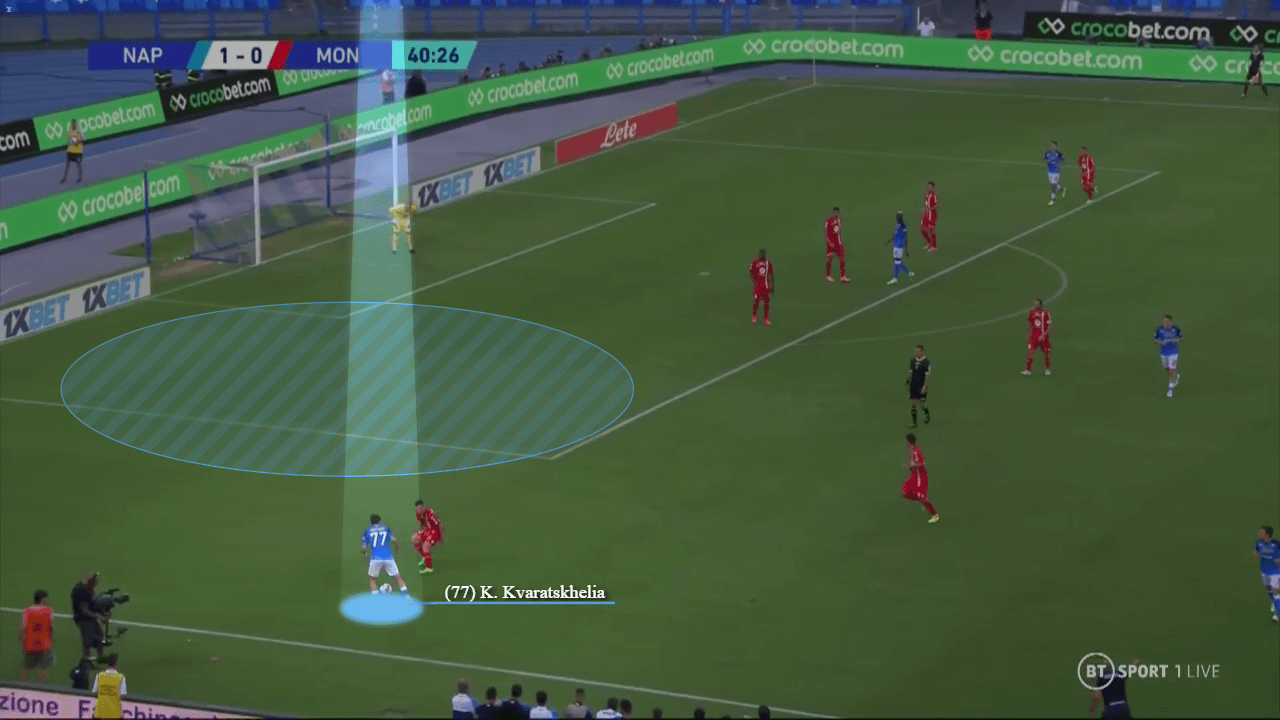
Set-play routines
A big part of Napoli’s success has also come through their set piece routines. One common theme has been to look for the South Korean defender Kim in corner situations. One way in which this has been done is by creating space at the back post for him. All the other players make a run towards the front post, which also causes Kim’s marker to step forward, creating space at the back post for Kim to attack the header uncontested. Monza’s man-marking tactic means there is no one at back of the six yard box to even attempt to win the header.
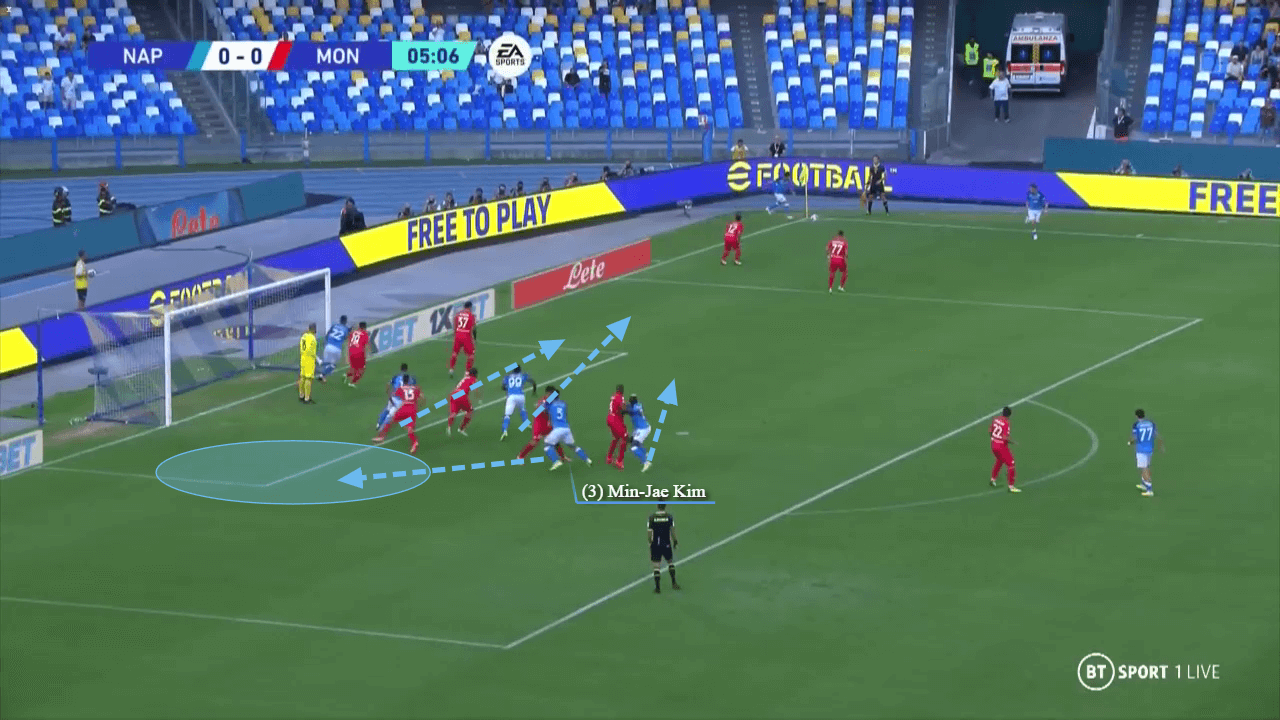
With the theme of one player attacking the back post whilst the rest attack the front post remaining the same, Napoli have altered the ways in which this can be a threat. This example below shows a corner aimed towards the front post, with the objective of finding space at the back post remaining the same. The player at the near post flicks the ball to the back post where Osimhen can attack the ball unmarked and get an easy finish.
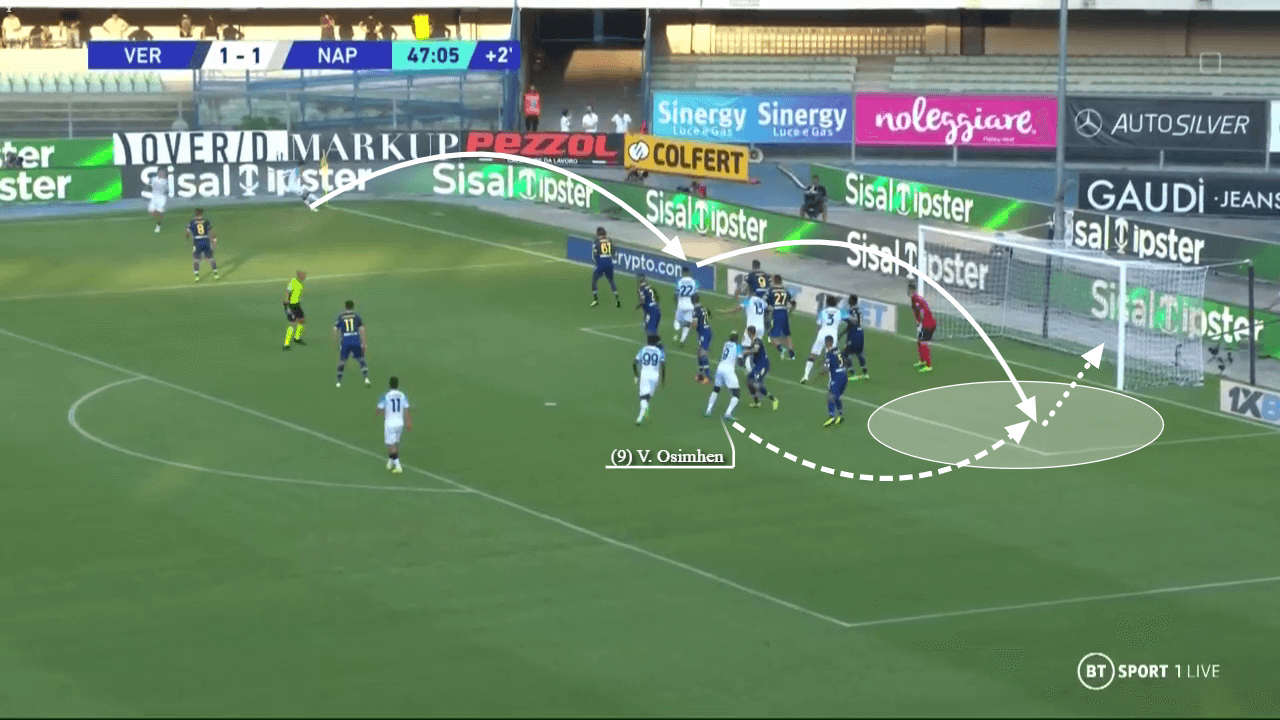
It is not only from corners, but also from throw-ins where Napoli have caused a threat. In the diagram below, you can see Zambo Anguissa purposefully stand in the way of Lozano’s marker, which gives Lozano time and space to receive the ball unmarked. Lozano attacked the space in which Zambo Anguissa vacates, while Zambo Anguissa took the attention of both of the defenders. This extra bit of attention to detail has helped Napoli be a threat in any phase of play.
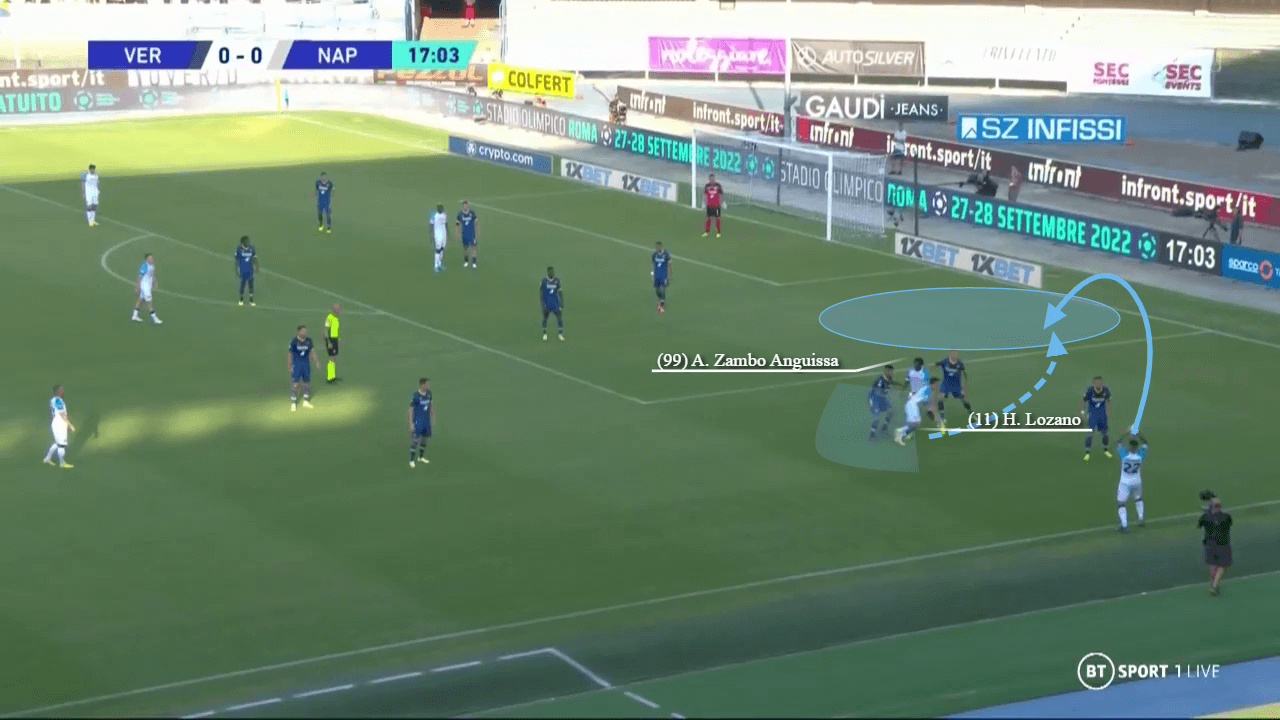
Pressing from the front
A big part of Napoli’s ability to dominate games is through their ability to force opponents to make errors through relentless pressing, especially in the first half of games. This image below shows how Napoli press man-to-man down the side of the pitch, so when the Monza defender Marlon attempts to play a low pass, Lobotka can be in the right place to intercept and begin a counterattack in the final third. Napoli will have to make sure they are mentally prepared to press for the full 90, in order to prevent standards from slipping in the latter stages of games.
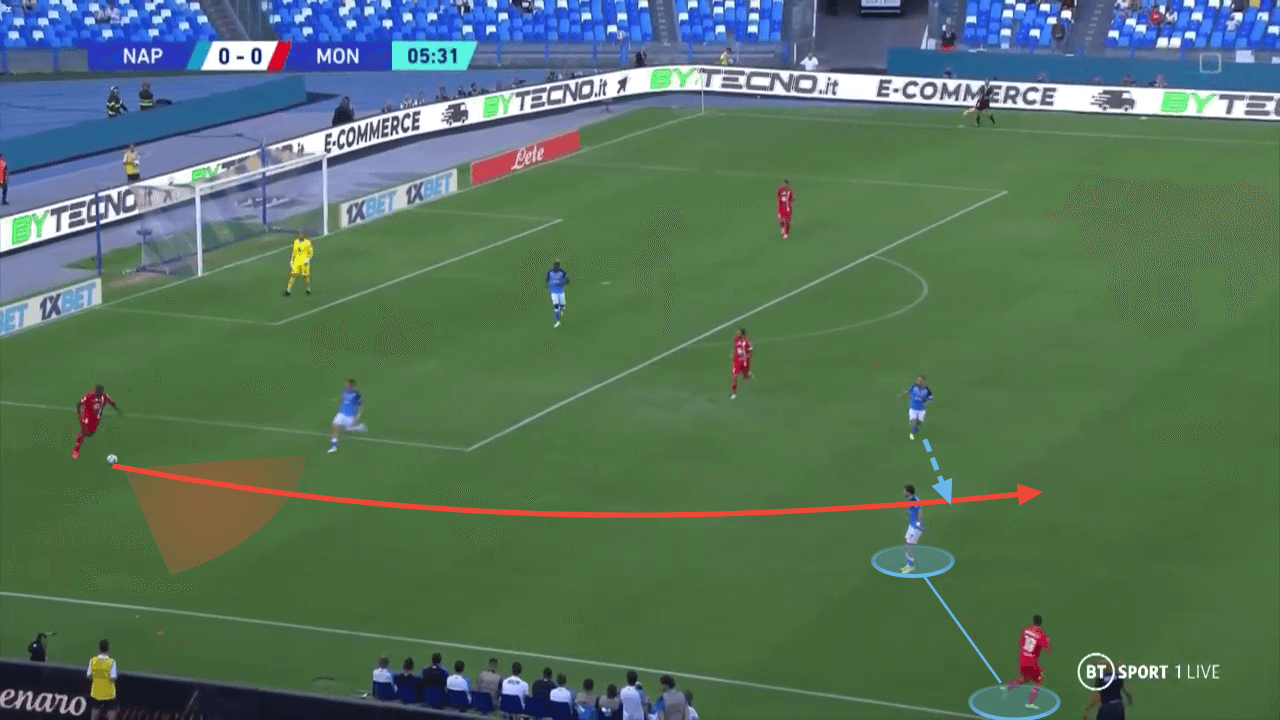
Threat in transition
When teams do attack Napoli, they must be sure to leave enough athletic defenders back to deal with Napoli’s counterattacks. Osimhen and Lozano are both very powerful runners which makes them incredibly tough to tackle when there is lots of space behind. Especially with Osimhen’s ability to hold the ball up, like in the image below, it is nearly impossible to contain him and you must prevent the ball from getting to him in the first place. The createive likes of Khvicha and Zielinski are very skilled at finding the runs of the forward players, something which will become a more common occurrence against teams that are more attack-minded.
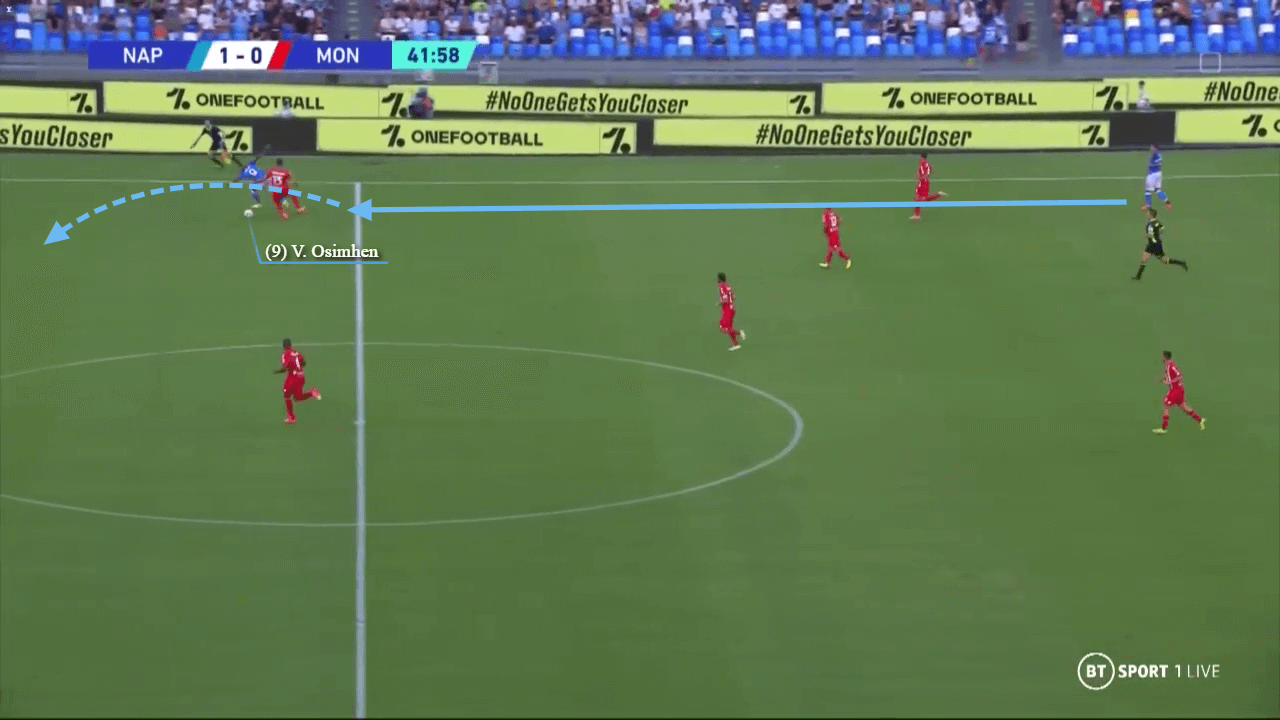
Intense counterpressing
Like when they press, Napoli also counterpress just as intensely, which plays a key part in their ability to sustain pressure on opponents and allows them to have a better defensive record. The Napoli players all mark the nearest open player while the player closest to the ball forces play one way, to reduce the number of potential outlets a Monza defender might have. This intense pressure is a key part of why Napoli sustain attacks and maintain a high possession number over their opponents.
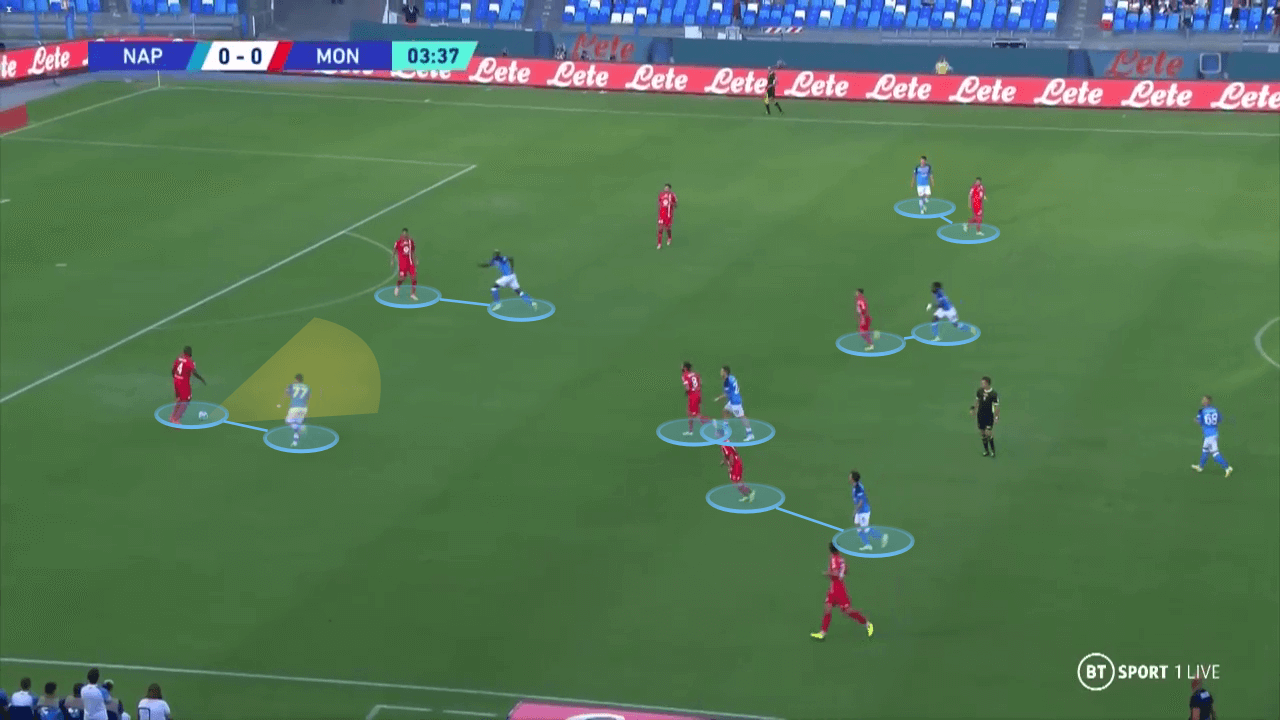
Conclusion
This tactical analysis has hopefully displayed just how dangerous Napoli are on the ball, intense and solid off the ball, and creative in set-pieces. Smart recruitment, combined with impressive tactical coaching has allowed Napoli to start the season better than anyone, and while the opposition may not have been the hardest, this style of play will cause problems for any team in the league.
We can expect Napoli to dominate most games in the league, and cause chaos for any defence. Their defensive structure hasn’t been tested too much, so some problems may arise, but with this pressing approach, this situation won’t happen too often.
Napoli should be considered title challengers for the season ahead although their squad may be a little inexperienced. While their squad may not be as strong as teams like Inter Milan, Juventus, or current holders AC Milan, they will definitely be up there come the end of the season and could hope to go on a little run to the knockout stages in the Champions League.






Comments